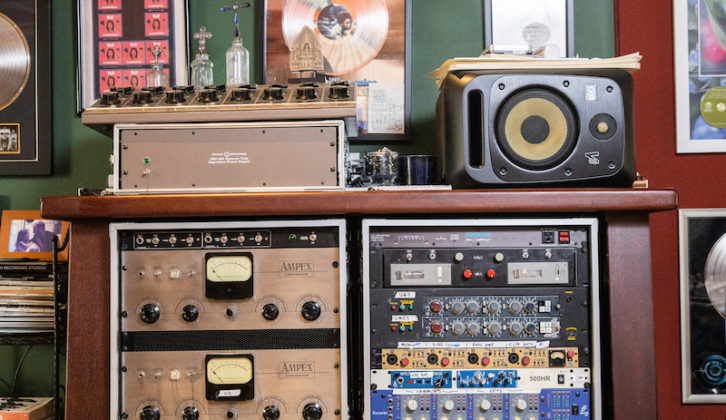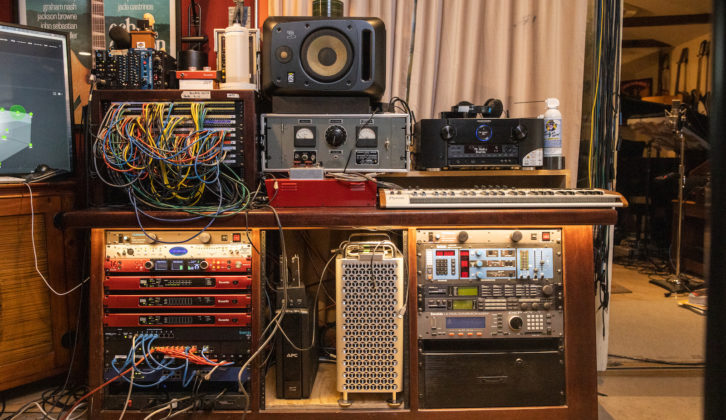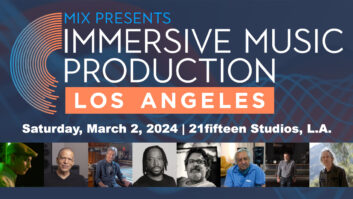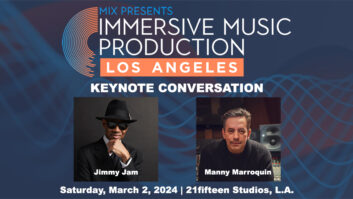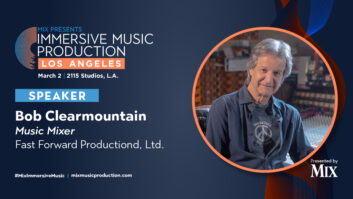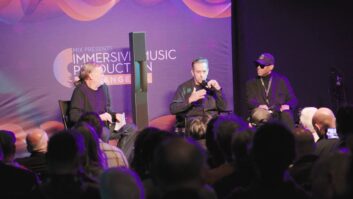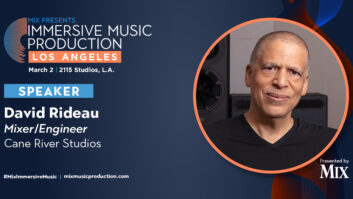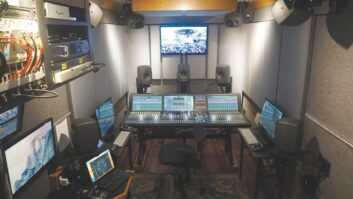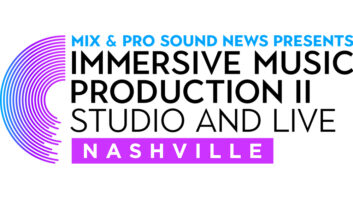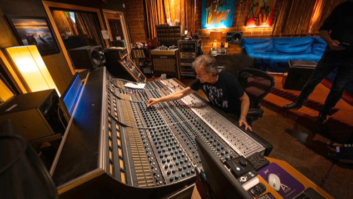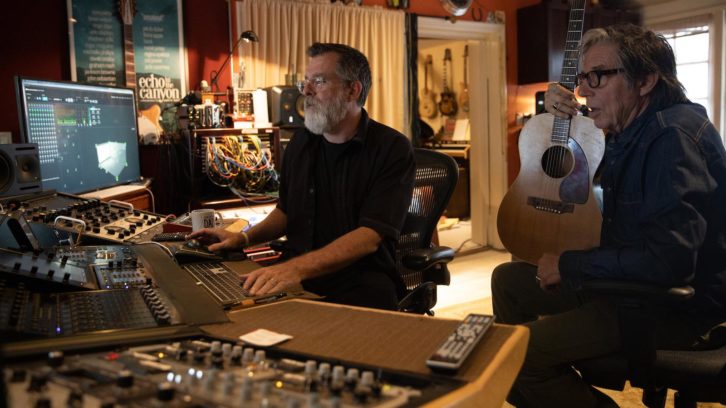
Until a few years ago, Dave Way was pretty much a stereo mixer in a left-right world, and he had proven pretty adept at it, working in the early days with producer Teddy Riley and later on Gold and Platinum hits with Toni Braxton, TLC, Babyface, Whitney Houston, Michael Jackson, Ziggy Marley, Christina Aguilera, Savage Garden, Macy Gray, Pink and so many others, including nine albums with this month’s cover mate, John Doe, formerly of X and now an increasingly prolific artist on his own.
Over the years, he has earned four Grammy Awards and been nominated countless times. In 2019, he shared a nomination with Bob Clearmountain for Savior by A Bad Think, in the Best Immersive Audio Album category, which is a tiny bit ironic, seeing as Way was never really a fan of mixing in 5.1. (See Mix March 2021 for a story on the follow-up, Lifelike, again with Clearmountain, Way and Michael Marquart.)
Dolby Atmos, however? That’s a much different format and a much different story. Way has embraced immersive mixing in a way that finds him talking about music like he’s a teenage boy picking up his first guitar. He’s become an open evangelist for the creative possibilities of Dolby Atmos Music, from composition to consumer playback. And he clearly remembers his moment of conversion.
It was at the 2019 NAMM Show, in the PMC Booth, where Maurice Patist set up a 7.1.4 system in an enclosed room on the floor and Steve Genewick of Capitol Studios played back sample tracks, taking audience requests from a printed menu-style list of songs that had been worked up for Universal Music Group’s impending rollout of some 3,000 titles on TIDAL by the end of that year. When the history of Dolby Atmos Music is written, that NAMM Show setup and its impact on the professional community will likely have its own chapter.
“The first time I sat down and actually listened to a music mix in Atmos was at that NAMM show,” Way recalls. “ The first time I heard ‘Rocket Man,’ I thought, ‘Oh, yeah, this is different, this is incredible. Honestly, I went in there very skeptical and not really planning to stay more than a song. I was never even a big fan of 5.1, but when I sat there and heard ‘Rocket Man’ and then sat for a couple more things—I probably sat there for an hour and listened to a bunch of different styles of music. Some I thought were amazing, and some I thought were okay. But what I realized right then is that this is all really up to the mixer as to whether or not a song is going to be great. The ideas of what you could do with this really got me going, and so that’s when I really started paying attention and asking questions. For the next year, I started doing my research and kind of getting up to speed.” Though he consistently interjects that there is a technical and creative learning curve to take into account for those entering the field, it didn’t take him too long to get up to speed. By the end of the year, he was involved in his first Dolby Atmos project, co-producing and engineering Aloha Radio Hawaii for Chinese label Rhymoi Music.
TRACKING LIVE WITH ATMOS IN MIND
“I had a Chinese client that wanted to do a record and I suggested we do an album of Hawaiian music, recorded specifically to be mixed in Atmos,” Way says. “The label producer didn’t know anything about it, but I convinced him that this is soon going to be a big thing. I got some great musicians and great arrangements put together, and we just went in and cut the whole thing live on the floor. And I basically recorded it as if you were just sitting in the middle of Henson Studio with all these great players surrounding you. I put up a bunch of stereo-pair room mics, and they recorded it all in two days with no headphones. It was fantastic.
“I knew that this Hawaiian record was going to be very much the idea of feeling like you were in a studio in 1940 because all these songs are classic Hawaiian, the kind they call the happy holiday period where it was jazz-influenced,” he continues. “I knew the room was going to be a big part of it because back then, everything was recorded live and everything was leaking into all the mics— I wanted it to be like that, except now you’re going to feel like you’re inside of it rather than it coming at you in mono.”
The hour-long listening session at the NAMM Show included all genres and styles of music, which proved a particular attraction to Way, who despite his early bent for hip-hop has developed a diverse and wide-ranging discography, from pop to rock to jazz to film scores. All, he says, lend themselves to an immersive mix in their own way; same as in the stereo world, the song and the arrangement help to determine the approach to the mix.
“There’s the natural way to approach a mix and there’s the gimmicky approach, with things moving around and making your head spin, taking advantage of all the movement that’s possible,” Way says. “The concept behind the Hawaiian record was to be natural, capturing the room and the players in it. Then the second record that I did—and these are records that I produced, so I’m fortunate to have kind of a say in how they were recorded—was basically with one guy, Michael Marquart, and it’s a very different kind of music; it’s very layered, very overdubbed, lots of movement around speakers, lots of ear candy. It was composed and arranged with movement of these pieces to be coming out of different speakers, whereas the Hawaiian album was meant to be inside of it, not moving around.
“Those are two very different ways of doing things, and there’s a whole lot of ways in between. I love the fact that you can put on ‘Tell Me Something Good’ by Rufus, and Chaka Khan’s vocals are coming out of the back speakers and coming out of the front. On a song like that, it really works because it’s almost like everyone’s playing in different time signatures, even though they’re not.”
SETTING UP WAYSTATION
Following Aloha Radio Hawaii, but before mixing A Bad Think, Way set about upgrading his home studio, Waystation, for 7.1.4 monitoring. Throughout the 1990s, Way was a part owner of The Pass studios. With the birth of his daughter in 2002, he decided that he wanted to spend more time at home, so he built out Waystation in his new home, which had been previously owned by Julian Lennon and included a well-tuned studio with vaulted ceiling.
He installed an SSL 6000E console and a slew of monitors to go with his ATC mains, so that he could check his mixes. A little more than three years ago, he switched to KRK monitoring with the launch of the company’s V8 line. Today, he mixes in Pro Tools, and his two V8s have grown into seven V8s for the LCR and surrounds, with four V6s in the ceiling and two 10-inch KRK subs below his desk.
“I started mixing on these KRKs just because I liked the musicality right away,” he says. “I very quickly found that I was getting mixes faster and I was enjoying it. I felt like I could hear the music tell me what I needed to do quicker and easier, and everything translated really well across the board. When I went to Atmos, I went with more KRKs.”
It took Way a while to figure out how to judge what he was hearing, for the simple fact that there were very few studios in town that could play back immersive music mixes. He was used to referencing mixes on up to six or seven sets of stereo speakers, but this is the early days of Atmos mixing and finding comparable rooms for playback is difficult.
He generously credits Steve Genewick and the team at Capitol for helping him out at the start with workflow tips and reference monitoring checks. He would also check mixes at PMC’s Hollywood studio and anywhere else he could. By the time the Marquart project rolled around, he was confident in translation to the downmix and with the binaural settings in the Dolby Renderer. Now, rather than finaling a mix in stereo and then building out to 7.1.4, he is confident in mixing to Atmos, then checking the downmix and binaural.
The Atmos workflow is based around Pro Tools sent to Focusrite RedNet32 converters with Dante, another technology that Way was familiar with, but just enough to be dangerous. He thought that he would get by with 64 channels of the max 128 in the Atmos spec. He now goes 128 channels bi-directional over Dante. He also uses a Focusrite monitor controller. He is thrilled with how Waystation sounds; he is more than confident in its translation.
CALLING JOHN DOE
Among Way’s many and varied client list, John Doe is special. The former X bassist, who two years ago was part of the band’s first album in 35 years, Alphabetland, has been unusually prolific of late, both live and in-studio. His most recent, soon-to-be-released project is his ninth with Way, either engineering, writing, co-producing or all three.
The relationship goes back nearly 25 years, to when Way was paired up with X to produce a version of “Wild Thing” for the movie Major League II. The studio gave the band free rein, not realizing what they unleashed; they ended up not using the X version, but it did cement a lifelong creative friendship between Way and Doe.
This last time around found them in Doe’s new hometown of Austin, Texas, tracking live with his band Folk Trio, with special guest Steve Berlin, in Public Hi-Fi Studios. Again, Doe set up a slew of stereo pairs as room mics.
“To me, X and Los Lobos are the two iconic bands of Los Angeles, at least among those still performing, and here I am in Austin with John Doe and Steve Berlin,” Way recalls with a bit of humble awe. “John is now a good friend, but he’s also one of my favorite songwriters and just one of my favorite people. He’s honestly just one of the coolest guys on the planet.” Way took the tracks back to Waystation, and worked up a few Atmos mixes. Doe, still not familiar with the immersive intent, flew out to Los Angeles, and Way, breaking a Steve Genewick rule of “never playing a client their own song the first time they hear Atmos Music,” played him his own songs, his own voice.
“I played him the first couple of mixes, and I saw his mind was blown,” Way recalls with a laugh. “He said, ‘I can’t talk. Play me some more because I love it, but my brain can’t wrap my head around what I’m hearing.’ He had no reference at all, but he instantly loved it. He particularly loved it after we checked it in stereo—where it felt more normal—and then once we switched back he said, ‘Now I understand it.’”
Way loved it, too, and he’s loving the entire process of rediscovering ways to compose write, arrange and record music. “I think we’re just at the beginning of this,” he concludes. “I think everybody’s really just starting to feel comfortable in this new sandbox, which is whatever you want to make out of it. We’re at the beginning of people conceiving compositions and productions with a full sound field in mind because it really breaks things open. I’m super excited about where we’re at and where we’re headed.”
